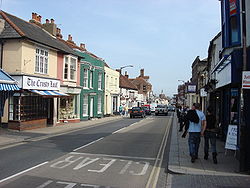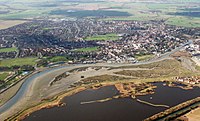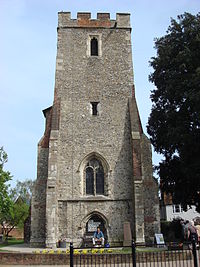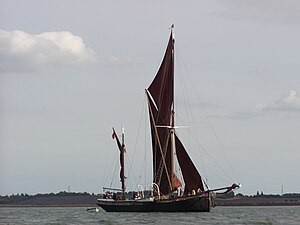Maldon
| Maldon | |
| Essex | |
|---|---|
 Maldon High Street | |
| Location | |
| Grid reference: | TL848070 |
| Location: | 51°43’54"N, 0°40’33"E |
| Data | |
| Population: | 15,513 (est.) |
| Post town: | Maldon |
| Postcode: | CM9 |
| Dialling code: | 01621 |
| Local Government | |
| Council: | Maldon |
| Parliamentary constituency: |
Maldon |
Maldon is a town on the Blackwater estuary in Essex. A pretty town and ancient, its high street runs down the hill to the town's key on the Blackwater, where Maldon's second heart lies.
The Blackwater here is broad, though at low water its channel shrinks to a narrow river slicing through the black mud. By the key are found the famous Thames sailing barges, their red sails once a familiar sight from here to London.
Contents
History
The place-name Maldon is first attested in 913 in the Anglo-Saxon Chronicle, where it appears as Mældun. Maldon's name comes from Mæl meaning 'monument or cross' and dun meaning 'hill', so translates as 'monument on the hill'.[1] It became a significant Saxon port with a hythe or quayside and artisan quarters. Evidence of imported pottery from this period has been found in archaeological digs. From 958 there was a royal mint issuing coins for the late Anglo-Saxon and early Norman kings.
Maldon was one of the only two chartered towns in Essex (Colchester was the other), and King Edward the Elder is thought to have lived here while combating the Danes who had overrun North Essex and parts of East Anglia. A Viking raid was beaten off in 924, but in another raid in 991 the defenders were defeated in the Battle of Maldon. The Vikings received a payment of “Danegeld” and apparently did not attempt to sack the town. It became the subject of the celebrated Old English poem The Battle of Maldon. The battle is commemorated by a statue on the quayside of the slain Saxon warrior Byrhtnoth.
According to the Domesday Book there were 180 townsmen in 1086. The town still had the mint and supplied a warhorse and warship for the king's service in return for its privileges of self-government. The town was awarded a charter by Henry II in 1171, stating the rights of the town as well as defining its borders and detailing its duty to provide a ship for the monarch "when necessary".[2] The town's All Saints' Church, unique in England in having a triangular tower, dates from around this period. While the precise building date is unknown, the church existed by 1180, the date of the foundation of nearby Beeleigh Abbey. A Charter of Richard I of December 1189 confirms “certain grants to Beeleigh Abbey, including the Church of Blessed Peter in Maldon and the Church of All Saints’ in the same town".
There were strong urban traditions, with two members elected to the Commons and three guilds which hosted lavish religious plays until they were suppressed by Puritans in 1576. Then, until 1630, professional actors were invited to perform plays, which were also stopped by Puritans. From 1570 to about 1800 a rival tradition of inviting prominent clergy to visit the town also existed. In 1629 a series of grain riots took place, led by the wife of a local butcher.
In the seventeenth century Thomas Plume started the Plume Library to house over 8,000 books and pamphlets printed between 1487 and his death in 1704; the collection has been added to at various times since 1704. The Plume Library is to be found at St Peter's Church. Only the original tower survives, the rest of the building having been rebuilt by Thomas Plume to house his library (on the first floor) and what was Maldon Grammar School (on the ground floor).
Maldon was chosen as one of the landing sites of a planned French invasion of Britain in 1744. However, the French invasion fleet was wrecked in storms, and their forces never landed.
In Maldon's parish church of All Saints is a memorial window to George Washington, whose ancestor, Lawrence Washington, is buried here. Unveiled by an American diplomat on 5 July 1928, the window displays Saint Nicholas with the Mayflower, Saint George and Saint Joan of Arc in the centre. At the top are the arms of the Washington family, and the arms of the USA, England, Scotland and Wales. At the bottom are depictions of George Washington, the landing of the Mayflower, the signing of the Declaration of Independence, and the Statue of Liberty.[3]
Transport
Maldon's first railway link was a branch line to Witham opened in 1846. Later a second line linked Maldon with Woodham Ferrers on the Crouch Valley Line between Southminster and Wickford line. Whilst Wickford is itself on the line between Shenfield and Southend (thus providing Maldon with another route into London Liverpool Street), a short-lived spur line at Wickford also gave direct access towards Southend.
Edward Arthur Fitch, writing in about 1895, states that from London's Liverpool Street station to Maldon East station via Witham there were eight trains on weekdays and three on Sundays and that via Wickford there were five trains on weekdays and none on Sundays. The fastest train took 85 minutes via Witham and 82 minutes via Wickford.[4]
The line between Maldon and South Woodham Ferrers closed to passengers in 1939, the Maldon and Witham line closed in 1966. The nearest railway stations to Maldon are now Hatfield Peverel, Witham and North Fambridge. Hatfield Peverel is the closest railway station to the north of the town, whilst North Fambridge is closest to southern parts of the town.
Culture
Maldon is known as the foremost modern-day centre for Thames sailing barges, and the distinctive barge forms a badge for the town itself. These are among the last cargo vessels in the world still operating under sail, albeit now used in the spheres of education and leisure.
Some ten to fifteen of the surviving fleet of Thames sailing barges count Maldon as their home port, and many others are regular visitors alongside at the Hythe quay. An annual sailing barge race ends with a parade of sail and prize-giving at the quay. The yard where barges were once built is still working at the end of Maldon quay.
The town holds an annual "Taxi Day" which sees mentally and physically disabled children from London driven to Maldon in London Black Cabs for a fun day of activities and a meal. The event dates back to 1952 when a London cab driver visited the Elizabeth Fry Special School in Plaistow. He wanted to do something special for the young patients he saw there. He wrote to every one of Essex's seaside towns to arrange an outing and the only town that was willing to help was Maldon, thus Taxi Day has remained a tradition ever since.
Every year around New Year's Day, the town holds the charitable Maldon mud race where competitors race across the Blackwater estuary at low tide, along the bank and back through the water.
Each year, on the first two Thursdays in December, the town holds a special evening known as Victorian Evening which celebrates the Victorian times. Local people dress up in typical Victorian attire and run stalls selling traditional food and handmade items. On these evenings the local shops and restaurants stay open late to allow the public to shop for longer.
Maldon in popular culture
Maldon and the surrounding area are the setting for a series of books by the prolific author, S L Bensusan.[5] Bensusan's stories recall a lost way of life among the towns and villages in the area, and along the local coastline and marshland. In Bensusan's books, Maldon is called Market Waldron.
On television Maldon has been a setting for numerous productions, including "The Lawless Heart (2001) and BBC1's "Murder Game" (2003) where numerous Blackwater Estuary locations were used including Green's Flour Mill at the bottom of Market hill and Steeple Marshes.
Maldon features in H G Wells' 'The War of the Worlds'; it is the town from which the narrator's brother and two female companions manage to escape across the channel.
Maldon was also the setting for one episode of the TV series 'Lovejoy' featuring Ian McShane.
Sport
- Cricket
- Football:
- Maldon & Tiptree FC
- Maldon Saints youth football and other developed youth teams
- Rugby: Maldon Rugby Union Football Club, founded in 1947 by the landlord of the King's Head on Maldon High Street.
Business
Maldon Sea Salt has been produced in the town since 1882 by the Maldon Crystal Salt Company.
The Fat Man of Maldon
Edward Bright (1721–1750) was the "fat man of Maldon", a grocer who, at 47.5 stone was reputed to be the fattest man in England. Etchings of a painting of him were much sought just after his death and his chair resides in the Moot Hall.
It is said that a man once bet Bright that seven hundred men could fit in his waistcoat. Bright rose to the challenge and gathered seven men of the Hundred of Dengie, who could indeed together fit in Bright's waistcoat. Bright’s portrait was painted in 1750 by David Ogborne (1700–1768), after whose painting various etchings were published. In 2000, a bronze relief of seven men in Bright's coat, by sculptor Catharni Stern, was installed at the King's Head Centre off Maldon's High Street, near Bright's former home.
Pictures
Outside links
| ("Wikimedia Commons" has material about Maldon) |
- maldon.angle
- Its About Maldon
- All Saints Church
- Maldon Weather Forecast
- Plume School, the main Secondary School in the area
- Newly formed Maldon Youth Choir for singers aged 16-30
- For 'What's on in Maldon' and loads more visitor information
- Maldon Rugby Union Football Club
- Maldon Art Trail
- Maldon Festival of Arts
- Thomas Plume's Library
- Maldon's Annual Oyster Festival
- Christian Outreach Centre Heybridge & Maldon
References
- ↑ Eilert Ekwall, Concise Oxford Dictionary of English Place-names, p. 312.
- ↑ "Maldon Town Council: History & Heritage". http://maldontowncouncil.gov.uk/history-heritage. Retrieved 18 August 2010.
- ↑ "All Saint's Church Maldon". www.itsaboutmaldon.co.uk. http://www.itsaboutmaldon.co.uk/allsaints/. Retrieved 17 July 2012.
- ↑ Fitch, Edward Arthur: Maldon and the River Blackwater. Gowers 1895.
- ↑ http://www.theindexer.org/index.php?option=com_content&task=view&id=77&Itemid=54 theindexer.org






